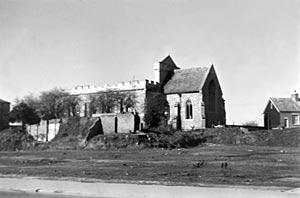
St Sidwell's Church, Sidwell Street
Page updated 13 September 2009
The present St Sidwell's is a 1950's replacement for the much modified Saxon church which was destroyed in the May 1942 bombing raid. The first St Sidwell's church was essentially a country outpost to the mother church of St Michael's in Heavitree. In 1549, during the reign of the protestant Edward VI, the prayer book rebellion flared up. The introduction of the Book of Common Prayer, along with the removal of Catholic images of saints from churches enraged many. The rebellion spread to Exeter when a Cornish contingent who were marching to London to protest to the King, joined with Exonians outside the city. The city gates were firmly shut against the hoard so they tried to burn them down. The crowd captured St Sidwells and used the church tower to hold their prisoners. The father of Sir Walter Raleigh was one who was held, because he had chastised a woman for carrying a rosary. The siege lasted for five weeks and was eventually relieved by Lord John Russell who made an example of the ring leaders and sent the rest home.
The church was rebuilt in 1812-13, in the Gothic style, and the octagonal spired tower repaired in 1823. It contained a clock and a peal of 10 bells, 8 of which were cast by Mears and Stainbank, in London during 1773 and the odd two by the same founders in 1891. There were statuettes of St Sidwell and St Boniface on the chancel arch carved from Caen stone of St. Sativola or Sidwell and St. Boniface, by Harry Hems; St Sidwell's was his local church and his workshop was close by in Longbrook Street. The exterior was faced with limestone in 1883. The birth, death and marriage registers date from the year 1569.
Destruction in 1942
It was at 2.43 am on the morning of 4th May 1942 that a 250 kg bomb fell directly on St Sidwells Church, destroying it and knocking out the water main in the area. The tower did not collapse, but it was so badly damaged, that it was pulled down soon after. The replacement church was designed by Lucas, Robert's and Brown of Exeter in 1957-58. It is built of local brick with some art deco style decorative features around the window frames. It had been intended to incorporate a tower, but it was never built. One bell from the old tower was saved and is hung in a neat little 'bell tower' that cleverly conceals a bin store. In recent years, the interior was refurbished into 18 flats and a small chapel. It has become a thriving community centre with a small café and offers adult education courses. There is also a small community garden attached to the church grounds, which is a haven of calm just off a busy Sidwell Street.
Sidwella, Exeter's own, home grown saintly myth, supposedly lived during the Roman occupation, although some think it was later, during the 7th century. She was the daughter of a wealthy British Romanized family. Her father, a Christian, died leaving his young children in the care of a cruel stepmother. Sidwella, was a pure, devout and beautiful girl who regularly prayed. Her father left her the bulk of his fortune, making the stepmother, you've guessed it, bitter and jealous, so she plotted Sidwella's death. As Sidwella knelt in silent prayer in a cornfield the corn reaper, paid by her stepmother, crept up and cut off her head with a scythe. A spring of pure water appeared from the ground, where her head came to rest. The spring that was situated just behind the church, in Well Street is supposed to be where St Sidwella met her end.
There is a St Sidwells Church about 5 miles west of Launceston in Cornwall at Laneast. A third St Sidwell's Church, in Guyana, South America will be celebrating its 150th anniversary in August 2010, on St Sidwell's Day. This church was founded by a Mr Webber from Devon, who had been a parishioner of St Sidwell's, Exeter. He purchased the land and donated it for a church. The church was destroyed by fire in 1957 and rebuilt 1961-62.
Source: Kellys' 1897 directory of Exeter, Two thousand Years in Exeter by W G Hoskins, Exeter Burning by Peter Thomas.
 St
Sidwells Church in 2005.
St
Sidwells Church in 2005. The old St Sidwells Church.
The old St Sidwells Church. The bomb damaged church in 1949. Photo Maurice Swansborough
The bomb damaged church in 1949. Photo Maurice Swansborough
│ Top of Page │